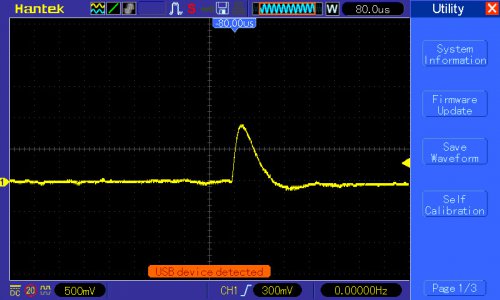Also FWIW, I didn't observe a substantial difference in the baseline noise level when I varied the detector bias voltage from 10V to 25V. This is an interesting result, suggesting the main contribution to noise is NOT the detector's dark current, since it should change quite a bit between 10 and 25V. I haven't characterized the detector's sensitivity vs. bias voltage, either.
I suspect the detector sensitivity won't change much, as long as the applied bias voltage is enough to sweep the generated carriers out of the PIN junction before many of them recombine. I should see what a zero-volt bias does, I guess; but I really need a known elemental sample to do this kind of characterization. Looking at random background pulses is an exercise in futility in this regard.
Setting the trigger source to the AC mains didn't reveal much, if any, 60Hz noise. With .25 inch-thick walls, my enclosure should be able to keep out a lot of 60Hz mag-field noise in addition to all of the E-field noise, so no surprise there.
Yes - just maybe.. and I say if it works, it works, then go for it!
I do love the pulse you have. I bet you had a bit of a "celebration"!
Indulging my deeper thoughts..
Carefully considered, I still think we only know where where we are when we can distinguish, and even perhaps measure, the dark current, and hence know the smallest energy which photons we might have an interest in would have to exceed, just to make themselves known. The dream wish is to see the contribution from Carbon, which would make a current of the same order as the diode noise when biased around 2V. [Carbon Kα1 = 0.3KeV]. Going for 2V bias comes at the cost of a whole 150pF to be charged and discharged, which would become the dominant "component" of what determines the pulse shape. This is assuming the other parts of the amplifier circuit do not also limit the response as to mask it.
10V bias drops the capacitance to 80pF, but raises the dark current to about 2nA. This is only worth doing if the bandwidth of the amplifier can benefit from it. For detecting the lower energies, perhaps 3V is a reasonable compromise. Zero bias puts the dark current at 600pA, but with a madly large capacitance of about 0.5nF in shunt. In a high impedance circuit like this, that is almost a "smoothing capacitor". We have to wonder whether we still believe the content of any pulses produced.
You still have the Pocket-Geiger circuit as a test-bed, although having changed the op-amp. One would hope to see the total of all known noise currents that really do have to be there. If the noise figure of the entire front end transconductance amplifier is higher than the diode dark current noise, you would simply not see the dark current, which is not the same thing as finding it to be insignificant. If it sticks up more than about 2dB above the racket, we can get at it. The key thing is, not to make extra racket! Changing the feedback resistor to something much lower, and then piling on the gain in later stages, should tell you something, even if some of that gain is in the oscilloscope front end.
One thing I am not entirely clear on. When we see the value of "Dark current" plotted vs Reverse Bias in the X100-7 specification, is that a all a DC current? If it is, then we have to separate the DC from the noise component in the spec. We can somewhat bias away to reduce the capacitance, knowing that the noisy current is 6.1e-14 A/√Hz. That spec is for 12V bias. For 250kHz bandwidth, this makes about 15nA, which is somewhat too high. This is why I think 3V bias is better, or 2V if we can get away with it, and have an amplifier that won't spoil it.
Theoretically, the currents into the transconductance amplifier might be:
1. The thermal noise in the molecules bashing about in the first gain stage semiconductor within the op-amp itself - ie. it's own noise figure.
2. The noise going into the amplifier input via the feedback resistor - figure 4kTBR.
3. The noise already present on the injected bias current, added to the diode dark current noise.
4. Finally, the "noise" we do want to see - that of carriers provoked into conduction by a photon.
--------------------------------------
Not to misunderstand.. take all the stuff above as just one's passing thoughts when messing with this thing, and I do get it that we are not designing an instrumentation module for NASA to place on Mars. It may be that all of those niceties listed above are out of reach for us, but we can still get meaningful useful amplitude and duration pulses out of a practical test getup!
I think I may be just about as stoked about this result as you are!




